September 29, 2005
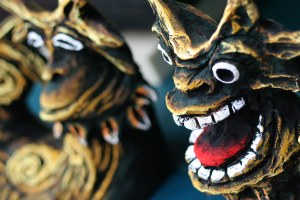

Okinawan buildings traditionally have sculptures of shisa — fierce lion-dog creatures — on their roof or gateposts in order to scare away evil spirits. When they’re found either side of a gate or door, one always has its mouth open while the other’s is always shut. Traditional shisa are sculpted in an old-fashioned Chinese-looking style, but on Ishigaki there’s a pottery that’s become quite famous for its crazy, bright-coloured 21st century shisa and shisa-inspired creatures. They’re very photogenic, but oddly, they seem to look a lot better in photos than real life. Or rather, they look the same, but in real life it’s easier to notice that they’re a bit too gaudy and crazy to sit comfortably against a background of less crazy objects… I think they’re still quite groovy though.
posted in
Okinawa —
1 comment
September 26, 2005

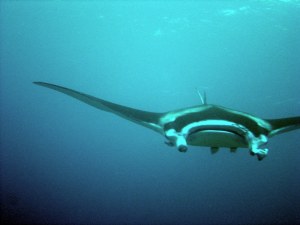
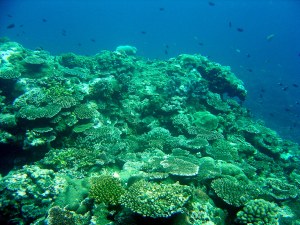
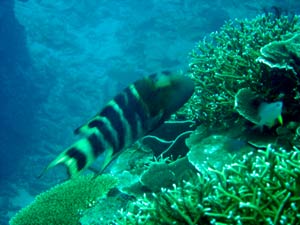
Well, I failed to dive the Yonaguni ruins, but after getting back to Ishigaki-jima I managed to dive to see manta rays. When we got back to Ishigaki from Yonaguni, k had to go back to Osaka, but I decided to stay on for a few days and dive with photographer and ex-JET Chris, who was down in the southern islands for photo-taking purposes.
We caught a boat out with a nice bunch of people from an Ishigaki dive-shop, who took us to an underwater rock a few hundred meters out to sea which the mantas seem to use as a meeting place. We dropped from the boat to the living coral 14m or so below, and began to look for mantas. Just as I was beginning to wonder if the search might end up being in vain, a large silhouette condensed out of the haze and we hunched down to watch it glide past. Soon, five or so others appeared. The largest we saw had a wingspan of probably about three metres. They were as strange, beautiful and graceful as mantas should be: about as strange, beautiful and graceful as anything.
Incidentally, Chris’s website has several galleries of lush photographs of Okinawa and Japan. And I designed it, oh yes.
posted in
Okinawa —
9 comments
September 23, 2005
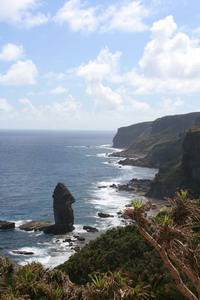
On Yonaguni, Japan’s westernmost island, I failed to dive to the kaitei iseki – the mysterious underwater structures that some people like to claim are the 10,000 year old relics of a vanished civilisation – and I also failed to see a living Yonagunisan, or Atlas moth, which (in Japan) are only found on Yonaguni. I also failed to see Taiwan, which is just over 100km away, although that’s not such a great failing, because apparently it is only visible on about ten days every year.
However, I did see Japan’s westernmost sunset, Yonaguni’s famous little horses, a rock that looked like a face (and which is, almost certainly for precisely that reason, called ‘human face rock’), and a huge bat, which was grumpily trying to find somewhere to sleep where the man who for unknown reasons was pestering it would not be able to get to it. It flew away downriver and successfully disappeared into the trees.
I couldn’t dive at the kaitei iseki because the sea was too rough, so I took a trip on a glass-bottomed boat instead – the only real alternative. Unfortunately because the sea was too rough to dive, it was also too rough to keep the boat still, so I had the frustrating experience of seeing only a few parts of the structure through a small, constantly-moving window. Diving would have been incredible, though… However, I left the island less persuaded than ever that these structures are man-made: an interesting fact about Yonaguni, which I have not seen mentioned in any discussion of the structures, is that a lot of the geology around the side of the island where the ‘ruins’ are is also very regular. Lots of natural flat rock surfaces at right-angles to each other, not unlike the ruins themselves.
posted in
Okinawa —
no comments
September 16, 2005
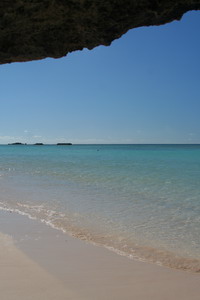
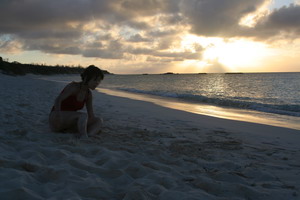
I’ve just returned to Ishigaki, one of the larger southern islands of Okinawa, from three days on Hateruma-jima – Okinawa’s (and therefore, by default, Japan’s) southernmost island. It’s a beautiful place, with a population of a few hundred people and probably a similar number of goats, and not much else apart from the whitest, cleanest beaches and bluest sea and sky I’ve ever seen, even in Okinawa. Very good home-made ice-cream too. I went and stood on the cliff-edge at the southernmost point of the island, and was for a few minutes the furthest-south person in Japan (people in boats don’t count, ok?)
Back from the south, tomorrow I’m taking the ferry four hours west to Yonaguni, Japan’s westernmost island – from which I’ve heard that Taiwan is sometimes visible on a clear day. I’m hoping to dive to the kaitei iseki (海底遺跡) – the pyramid-like formation on the sea-floor just off Yonaguni’s south coast. I will also try and find a place where I can be (for a few minutes anyway) the furthest-west person in Japan.
posted in
Okinawa —
3 comments
September 12, 2005
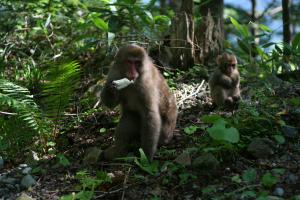
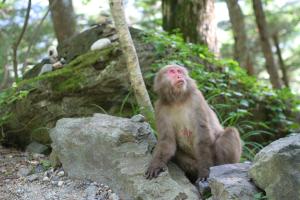
I got back on Thursday from travelling in mainland Japan, and I’ve been wanting to put up some of the pictures I took, and write about some or all of Nagoya, Takayama, Matsumoto, Kobe & Tottori (where Graeme and Japan’s only desert both live). But I’ve had no time, and in a few hours’ time I’m off travelling again: this time I’m catching the night boat to the southern islands of Okinawa. Ishigaki, and then probably Hateruma and Yonaguni – the last island before Taiwan, and the site of some mysterious ancient underwater structures that may or may not be man-made. I’ll be gone for about ten days.
So. In the mountains between Takayama and Matsumoto, I saw monkeys. Several dozen monkeys. And they were surprisingly unperturbed by human beings: I strolled nonchalantly past the first monkey a couple of times to see if it was bothered by me, but since it barely looked up, I spent the next hour or so sneaking up to monkeys and taking their photographs.
posted in
Okinawa —
6 comments
September 4, 2005
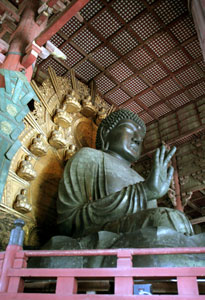
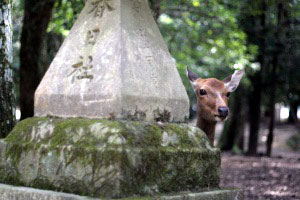
On Monday I went to Nara, which was, for a hundred years or so in about the 8th century, Japan’s first capital. I had a particularly excellent day because, going into the tourist information office in the morning to ask about that evening’s train times, I was offered a free guided tour by two university students who volunteer as English-speaking tour guides in order to practice their English. So instead of wandering around temples on my own, taking pictures and moving on semi-aimlessly, I spent the next six hours or so being shown round by two very enthusiastic and knowledgeable girls who actually seemed to think I was doing them a favour by letting them practice their English! I told them I would tell other people about their tours, and so if anyone reading this ever finds themselves in Nara, I’d highly, highly recommend dropping into the tourist information office and getting a free tour. They are available all year round (though the actual tour guides are different every day – they’re all students from nearby universities who volunteer a couple of times a month).
Nara is probably most famous for the Daibutsu – the giant bronze Buddha sculpture that is housed in the largest wooden building in the world (but which is, amazingly, only two-thirds the size of the original building). It’s also famous for the incredibly tame red deer that wander around the town, and which have been awarded National Treasure status by the Japanese government. I have photos of both Buddha and deer, but will have to wait until I get back to Okinawa before I can show you them.
posted in
Okinawa —
2 comments












